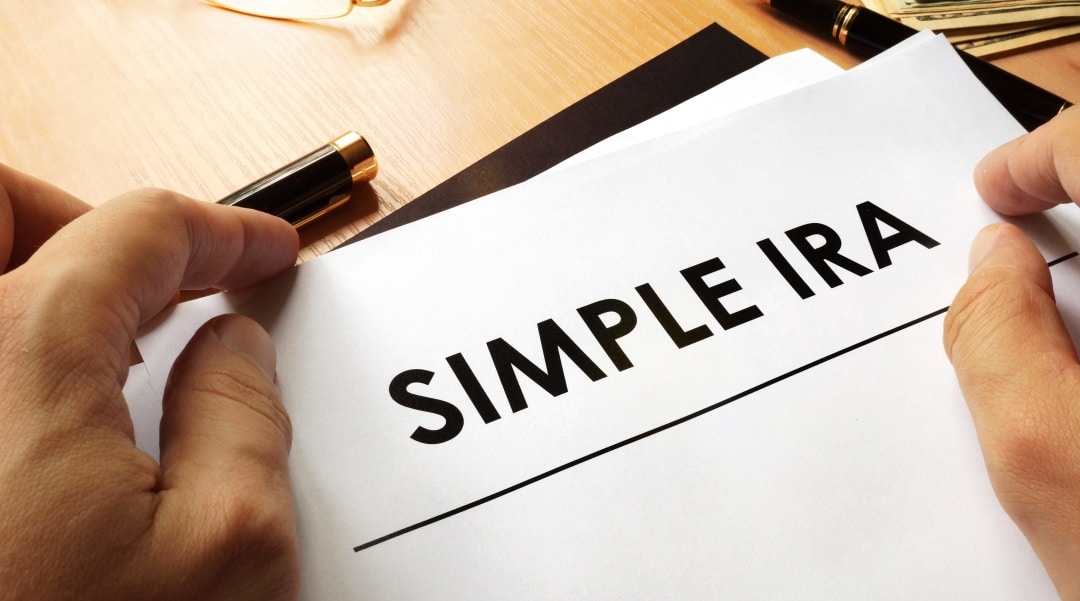Picking the right retirement vehicle can feel overwhelming. Especially as a business owner, with employees counting on you to help protect their financial futures. There’s an abundance of plans to choose from, and each has their own pros and cons.
As a firm that specializes in helping business owners, we hate watching employers spin their wheels on retirement. Or worse yet, choosing the wrong plan for themselves and their valued employees.
In this article we’re going to take a deeper look at the Savings Incentive Match Plan for Employees, or Simple IRA. We’ll cover its eligibility, benefits, drawbacks, and differences from other employer-sponsored plans like a SEP-IRA. Let’s get started.
What Matters In Simple IRA Eligibility?
Any employer (including those who are self-employed) may set up a Simple IRA. However, the employer must not have exceeded 100 employees that were compensated $5,000 (or more) in the previous calendar year. For this reason, Simple IRAs are best suited to smaller businesses.
According to the IRS, eligible participants for a Simple IRA include employees who:
-
- Were paid at least $5,000 during any 2 preceding years (don’t have to be consecutive)
- Are reasonably expected to make at least $5,000 in the current calendar year
Please note: That you have the option of reducing some of these requirements. The IRS allows for the elimination or reduction of the compensation cut offs for the past or current year. For example, if you had an employee who earned only $3,500 last year, they could still be allowed to participate in the Simple IRA plan.
What Are The Contribution Limits For Simple IRAs?
Simple IRAs allow for high contributions. But this amount will change according to IRS guidelines. In 2022, employee contributions limitations on Simple IRAs include:
-
- A maximum of $14,000 per employee in salary reduction contributions
- A maximum of $3,000 in catch-up contributions for employees age 50 or over
When it comes to employer contributions, you’ll have to choose between two methods each year and inform your employees of the decision. These include:
-
- A 2% non-elective contribution: This means you contribute 2% of each eligible participant’s pay regardless of how much they did or did not contribute themselves.
- A 3% matching contribution: This means you match eligible participant contributions dollar-for-dollar up to 3% of the participant’s total income.
- Note: You can match lower than 3%, but for no more than 2 years in a 5-year period. And you can not match lower than 1%.
Advantages Of A Simple IRA
1. Potentially Higher Contribution Limits:
Compared to some other retirement options, the contribution limits for Simple IRAs are much higher. In 2022, contributions max out for standard traditional and Roth IRAs at only $6,000 each year. Whereas with a Simple IRA, you can contribute over twice this amount ($14,000)
2. Allowance For Catch-Up Contributions:
In 2022, Simple IRAs, allow for catch-up contributions after age 50 ($3,000). Not all employer-sponsored retirement plans offer this (ex: SEP IRAs).
3. Tax-Deferred Contributions:
Contributions of any type into your Simple-IRA are tax deferred. So you’ll be able to write them off come tax time.
4. Easy Setup And Low Cost:
Simple IRAs are much easier to set up, and typically cost less to operate compared to plans like a 401(k).
Disadvantages Of A Simple IRA
1. Potentially Lower Contribution Limits:
Contributions limits for a Simple IRA may be higher than standard Roth and traditional IRAs, but there’s even higher limits with other plans. For example, a solo 401(k) has a staggering contribution limit of $61,000 (plus $6,500 in catch-up contributions) in 2022.
2. No Roth Option:
There’s also no Roth option with Simple IRAs. This means you don’t have the choice of taking the tax hit today, and withdrawing your money tax free later on.
3. No Additional Retirement Accounts:
As an employer, you are not permitted to have a separate IRA from your simple one. But with plans like a 401(k), you can.
4. Heavy Early Withdrawal Penalty:
Simple IRAs have a heavy early withdrawal penalty of 25% on any money taken out before age 59½.
How Do You Set Up A Simple IRA?
Simple IRAs live up to their name by being incredibly easy to set up. You’ll start by selecting a provider (ex: Charles Schwab, Fidelity, etc.). Then you can follow the steps outlined by the IRS, to get it up and running. These include:
-
- Develop a written agreement for providing benefits to all eligible participants. To do this, reach out to your provider, or use a IRS Form 5304-SIMPLE.
- Provide all eligible participants with the necessary information regarding the Simple IRA. If you’re using the IRS Form, you’ll need to give a copy to each participant.
- Create an IRA for each participant through your chosen provider.
Please Note: The Simple IRA setup deadline falls at any point between January 1st and October 1st each year. However, if you’re a business whose formation occurred after October 1st, you may establish a Simple IRA as soon as possible.
Learn About:
How Can Vertical Wealth Management Help?
At Vertical Wealth Management, we help business owners prepare for their retirements alongside their employees. That’s because we understand how stressful it can be finding the right plan on your own.
By working with our team, you’ll have a hands-on partner in evaluating your retirement options. We’ll find the plan that works best for your business, and answer any questions you may have along the way.
If you feel a Simple IRA may be right for you, have further questions, or want to explore your retirement choices, we’re here to help. Schedule your free consultation call today, and find the retirement plan that’s best for your business.

